Chapter 7 – The Created World
The creation of the world
What is the impulse that precedes the creation of the World, the boot-up of the supercomputer of the Creator, the World Mind? In other words, why was the World created? This is another problem beyond human understanding, but I will try to more or less faithfully quote the esoteric doctrine.
God (transcendent) wanted to know Himself. He wanted to look at Himself and created the World.
God wanted to know what is and He created what is not.
God, in his transcendent form felt His infinite capacity and, in order to test His infinite potential, created the World.
I used “World” deliberately because it is a broader concept than “Universe”. I only point out that “World” here means everything, except the transcendent God.
Here, the limitations of the human mind are again markedly evident, as it is only able to formulate a question. But even the mere wording of the question comes from presuming the human attributes of God, from the difficulty the human mind has to understand the absolute infinity of the Mind, God.
If we presume that God has a reason to create the World, we conclude that he was desires, that he is lacking something, therefore limiting him. A limited god is not God.
The presumption that the World Mind will create something to satisfy its own needs is logically absurd. How can God, who is absolutely perfect and absolutely unlimited, add something to His perfection and infinity?
It makes no sense to apply the question of the purpose of the creation of the World to the World Mind. The Created World is, has always been and will always be a natural part of God. The incessant creation of the World is a natural attribute, an essential trait of the World Mind. There has never been a decision to create the World.
The Mind, creator of time
The claim that time does not exist is inaccurate. What does not exist is the absolute, independent, linear passage of time. There is no doubt that our image of time as independent and linear is so deeply rooted that any alternative seems absurd.
According to an accepted definition, time is one of the basic physical quantities which measures the distance between events on the abscissa (the time coordinate) of space-time. It can also be defined as a non-spatial linear continuum where events take place in an apparently irreversible order. As such, it is an essential component of the structure of the universe.
The essence of this definition is that events take place in time.
But if we look at what the distance between events is measured with, we find that it’s measured with distances between other events; a circular definition. For clarity’s sake, let’s imagine that we measure time with a classic watch with hands. The unit of time is determined by the movement of the second hand, which is nothing but two different conditions of the hand, two events. What can we measure the distance between these two events with? Again only with other watches, with other events. Even if it was an atomic clock, the unit of time would always be limited by two events.
What if we created an intellectual structure where the relation between events and time is reversed? Imagine that time does not measure the distance between two events, but the opposite, that time is generated in relation to the creation of these two events.
In other words, and from a different perspective, this reversed relation can be also expressed in that it is not true that consciousness (the mind) creates reality in a time independent to it, but that it is true that the mind creates the events time depends on.
The divine World Mind, part of which are also our minds, creates the entire reality and thus also space and time. Therefore, time is created by consciousness (the mind). I am aware that it is not easy to resonate with the idea that time independent of consciousness does not exist, but if we follow the above premise, I believe that no other conclusion is logical.
If the World is a thought of God, so are space and time. If God does not think, then time not only doesn’t pass, but it does not exist. This also implies its relativity. Time always passes depending on thought, on the movement of information. That is why time passes relatively differently for each being (in the broadest sense of the word), and depending on the density of the information on a given point (forms and dimensions) of the World perceived and created by the being. This means not only the speed, but also the direction of time.
I’m aware that this concept (regardless of its possible or impossible probability) it’s very hard to imagine given all of our prior knowledge.
What was the situation when space and time still didn’t exist, before the big bang? If we start from a philosophical concept where the World is a thought of God, we can assume that God already existed before the big bang, and that he thought before it—he created the World— and if there is creation, it can be presumed, according to our previous ideas, that it took place in time. Any change in condition takes place in a specific time.
But what if we wanted to reverse this idea? Time as such does not exist and we disregard its non-existence with respect to its relation with space or matter (the existence of a material universe).
In this sense (the ability to perceive it), time is a manifestation of change and movement. Any change can be expressed as a gain, loss or change of information. Simply put, if nothing happens, time does not pass.
It is important to bear in mind the difference between time (its course) and measuring time. If nothing happens, clocks don’t run either. I’m aware that this concept seems unusual, but let’s imagine a word where there’s nothing but one virtual clock. Virtual so we can abstract it also from the movement of molecules, atoms, electrons, etc., in case it was a real clock. But this virtual clock doesn’t run, there’s no change of condition or information and time doesn’t pass; it could be said that it doesn’t exist. Time begins to pass the moment the clock starts. It can’t be said that the clock didn’t work for some time because no time existed. There’s no way to measure it, either, because there are no events to measure it with in this World.
This concept of time explains in a logically acceptable way what is otherwise inexplicable phenomena. For instance, the completely different passage of time between lives, seemingly incomprehensible shifts in time, including the transitions between alternative space-time systems (returning from different caves where time passes much faster than the travellers there, or vice-versa).
In expanded states of consciousness, we are able to live entire lives, or several lives simultaneously, while only minutes or hours pass in our reality. The same happens in NDEs, where, in a very short time (measured in this reality), the temporary dead go through their entire lives.
Also interesting from this perspective are how incredibly fast natural healers heal wounds, right in front of your eyes. This is because the healer creates very fast time with his mind (or rather, accelerates time) for the injured part of the body, and the injury heals relatively normally in its subjective time, but considerably faster in relation to the time of the surrounding entities (consciousness). This can be expressed as a thickening of the information process of healing.
The speed of time is determined by the thickness of the information (events). This is why time on Earth is accelerating. There are many more beings and therefore more different minds than before, and beings also perceive more information than before.
Consciousness (the mind) works like a time machine. A time machine is described as a device to shift over time, but a more accurate formulation would be that it is a device that creates time. According to this hypothesis, each consciousness is a machine like that.
The passage of time depends on the flow of information and is relative. Each consciousness (in the broadest sense of the word) has its own relative time that depends on the thickness of information. We know the expressions “time drags on” or “time flies”. It drags on when there are few sensations and information, and it flies when there is a lot of information, which is also relative to each subject. For example, some people will feel that the 90 minutes of a football game are an eternity (if they can’t perceive any other information), while that same time will pass very fast to others.
Time passes for everyone in their own closed system, independent to the time of other systems. For instance for societies and civilisations on Earth or for the organs of the human body or the cells of not only our body and also for each being including animals and plants. Scientists claim that each organ in the body has its own age, which corresponds to my experience. It is therefore a little misleading to compare the lifespan of animals, plants and humans measuring it with some sort of absolute time agreed on for most people in the world.
From this perspective, it is interesting the way aboriginal cultures perceive time, considerably differently from our usual perception of time.
This hypothesis explains many seemingly inexplicable phenomena.
Under this hypothesis, the theory of accelerating time gets a new dimension, as there is no doubt that the density of information is growing rapidly in the global space of Earth, due already to the rapidly increasing number of people, and the density of information per person thanks to the information revolution.
This hypothesis can explain the differences in the passage of time in other dimensions, and also between lives or in the astral world. In fact, it can explain the movement against the flow of time (apparent, from our perspective), if we assume that the direction time flows depends on the direction of the flow of information.
Once again, I will use my favourite analogy with a computer. Let’s imagine a computer full of information about the past, the present and the future, and maybe about alternative pasts, presents and futures. The movement across this information generates the direction of time, which, given the alternative pasts, presents and futures, could be not only backwards and forwards, but also up and down or left or right; or even diagonally, if it moves for instance from our present to an alternative future or past. The size of the units of time and its speed also depend on the density of information.
Time is not an absolute value measuring the duration of motion, but a relative one that depends on movement (change of information), or created by movement. Therefore, time depends on the creator of the movement, the consciousness (the mind). Unlike the commonly applied theories, where time in its linear form is how we perceive a complex reality in a succession of images, in this hypothesis time is formed by the creative activity of consciousness (the mind), the movement of information.
Therefore, the idea of a beginning or end of time, or its infinity or existence is misleading.
God, in his state of absolute, is free of all information and thus time does not exist for Him.
Before the big bang (assuming it really happened), time did not exist in our Universe, which, under the aforementioned hypothesis, is not even disturbing. For our Universe, time did not begin with the big bang; it was created by the World Mind together with the big bang. This, however, does not mean that relative (subjective) time doesn’t exist for the Consciousness independent of this Universe and the existence or non-existence thereof.
Just as it is very difficult to state that we know beyond doubt how another person exactly perceives colours, tones, emotions or feelings, it is very difficult to say the same thing about time. It is at least evident that the perception of time varies between cultures.
The perception of time as lineal or cyclic is related to how we perceive the information that makes our 3D reality. If we perceive it fractally arranged, we will sure tend to perceive time in its cyclic form, if we perceive it as more or less randomly arranged; it will be linear.
It is interesting that the idea that space exists only in our imagination is quite acceptable, but the possibility that time is also a creation of our mind is hard to imagine. Maybe it’s because the relativity of space is more acceptable than the non-existence of absolute time. Or perhaps it is because we are able to perceive space in three dimensions, whereas time only in one, which make absolute our perception thereof. Or it might be because we have a sense—sight—to perceive space (distance), but we don’t have one to perceive time. We only have senses to perceive the gauges of time.
Evolution does not happen in time, evolution (the summary of information comprising evolution) determines the direction time flows in the system that is evolving.
In this sense, there are no paradoxes such as: “Whether the chicken or the egg was first, whether plants that needed pollination were before the insects that pollinated them.” Likewise, under this hypothesis, ideas like “God had existed infinitely long and then he got bored and created the world” are illogical.
The Being’s model of the World
Everything that someone some time thought has been realised, is being realised or will be realised in the created World, because the World is nothing but a thought.
There’s an infinite number of Beings in the created World, beings of all degrees and levels in an infinite number of universes.
Each state of the Beings (which together make the Universe) indicating a particular past, present and future of the Universe are like quantum states of the Universe.
We must not forget that everything is a virtual reality, not only our real world, but also the astral world, the higher worlds (higher dimensions), the light beings, the angels, etc. Everything is a mental projection of the World Mind. I point this out because the concept of illusion is usually associated only with this material world.
Everything is an illusion. Everything is just a virtual reality. But not only our real universe, but also all the higher worlds like the astral world, and the higher dimensions or levels. On the other hand, even if it’s only virtual; there is no other reality and therefore, this material, physical world is our reality and we must approach it accordingly.
The mutual effect of entities is due to the fact that they work mutually tied in the same way as the one-dimensional strings stretched through space and time. A Being is always a certain string in space-time, affected by the other strings—Beings—and affecting them, too.
The further the impulse acting on the Being is in time and space, the smaller its effect. It also depends on the size of the impulse (the impact of a large meteor into an uninhabited planet in a distant solar system would have hardly any effect on us; the explosion of the star of that system could have completely different consequences). The following figure can provide a better understanding of this model (see Fig. 17).
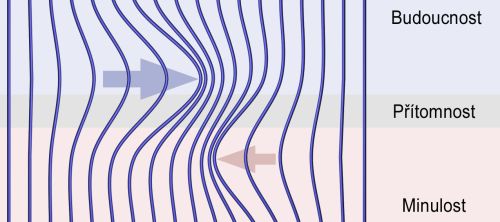
Fig. 17
The effect of each Being on the system as a whole is expressed as the pressure of each string (Being) on its surroundings. An act (in the broadest sense of the world, a thought is also an act in this model) of a Being is manifested as pressure on the Beings (strings) in its immediate surroundings, where this pressure is transmitted.
The effect of this act spreads through the nearby Beings in time and space as when you throw a rock in a pond and watch the circular waves propagating from the place where the rock hit the water. And like the waves, the size of the impulse (the wave) in this model also decreases with time and distance, and its effect on Beings far in time and space will depend on the size of the original impulse.
The difference with the example of the rock thrown into a pond is that, in our string model, the effect is possible also only in one or two directions and the spread of the impulse through the system is significantly influenced also by the counter-effect or the interaction of other Beings (other rocks thrown into the pond near the place of the first rock).
This model implies an interdependence and connection of all Being that leaves no room for chance. With this model, it is very easy to understand that the complexity of the interconnections of all Beings is arranged so that a super genius chess player able to calculate beforehand an infinite number of moves for all Beings is not needed in order to reach the desired result on the basis of all the mutually combined moves of all the Beings.
In fact, it’s not even necessary to assume a super genius programmer to achieve the desired result because it can be achieved setting a desired situation in the right point in space-time and the necessary initial conditions for the results will have already set the effect of the resulting impulse to the past.
Let me remind you that we are still assuming that past, present and future take place simultaneously.
God as the Creator can set the future of a specific point in space-time, and since a change in the future will alter the present and the past, it is not necessary to set each of the means needed to reach the goal. Therefore, the end affects the means. It is the reverse proposition that the means affect the end.
It is very easy to imagine this with the analogy of a computer game. The programmer can design the game so that, regardless of what alternative we use to move on, we always reach the same goal. The question is when and with how many points. Many computer games are designed this way.
To imagine this model of existence one must be freed from all dogmas such as “the future cannot affect the past”. In our model of existence it can, because everything takes place simultaneously, with mutual effects.
The following figures show simultaneously existing probabilistic models of future, present and past.
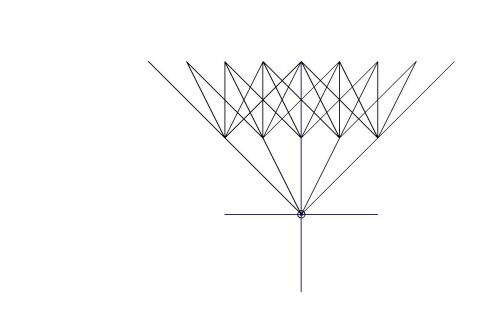
Fig. 18
The starting point is the present indicated with a ring and upwards are the probabilistic futures. At each point where two lines meet, the being can choose a certain path, until the decision on a probabilistic future.
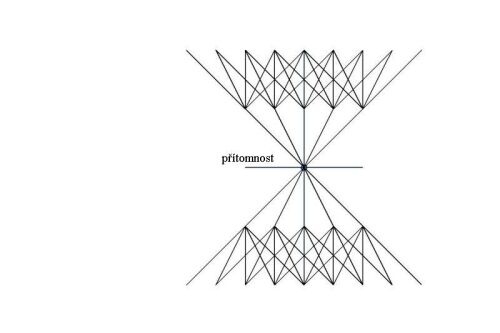
Fig. 19
The starting point is the present, indicated with a ring, and upwards are the probabilistic futures and downwards, the probabilistic pasts.
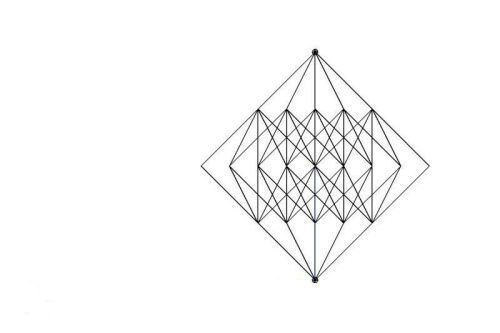
Fig. 20
This figure shows a model of a multi-dimensional being containing all its alternative pasts, presents and futures, and, for a more accurate picture, it should be seen as a great simplification of the four-dimensional model, where the starting and ending points are the same, which can be better illustrated with a cylinder.
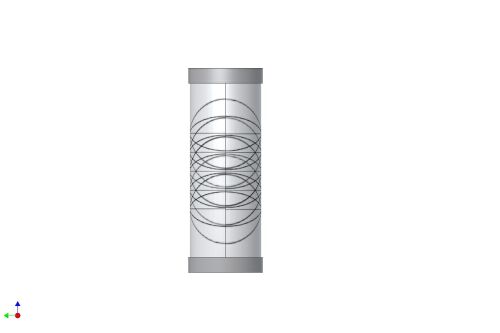
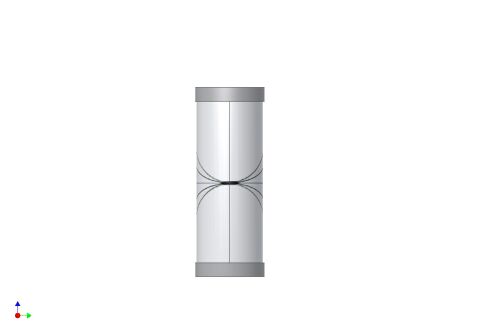
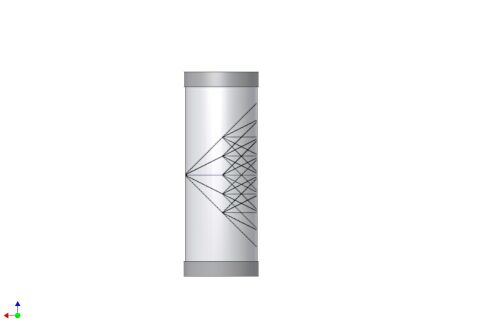
Fig. 21 a, b, c
This model can also be applied to the life of a human being, the “development” (between quote marks because, since everything takes place simultaneously, development basically doesn’t exist) of humankind, the Earth, the galaxies, the Universe, the consciousness of humankind, of the Earth, the galaxies and the Universe.
Time in our linear understanding does not exist. Everything happens simultaneously. The past, the present and the future take place at once. Our imperfect perception is able to perceive it only gradually. There isn’t just one alternative of the past, present and future. There are many, which are permanently created, simultaneously.
We perceive the past only as one alternative because our imperfect consciousness focuses on only one alternative. In states of greatly expanded consciousness, it is possible to perceive simultaneously many alternatives of the present, the course of several lives, in one instant. Of all the alternatives of the simultaneously created past, we only remember the one that has lead to the present that our consciousness currently perceives, on which the focus of its concentration is centred.
There are many alternatives of the future, but not all of them are possible continuations of the only present we perceive. Those futures that are possible continuations of the perceived present are called probabilistic. In states of expanded consciousness we can perceive one of the probabilistic futures, or several.
The ability of clairvoyance is therefore the ability to perceive one of the alternative futures happening simultaneously. The ability of a good clairvoyant is to choose the most probable future from the perceived alternatives. The more complex a situation is prior to seeking the future, the more the alternatives will be, with each becoming less probable. Therefore, clairvoyants cannot be considered frauds when a different future than the one seen happens. I’m speaking about real clairvoyants with real abilities, and not about frauds, of which there are plenty. What is crucial for the quality of a clairvoyant is the prescient vision of the probable alternatives of the future and their intuition when choosing the most likely.
It is clear from the above that many alternative futures are constantly created simultaneously with our present, of which only one is targeted by our present. Even though there are many alternative futures, only some are more likely for us. Even if we cannot completely exclude the possibility that tomorrow we will wake up in the other end of the galaxy, the probability that tomorrow morning we will wake up in our beds in much, much bigger. And the possibility that tomorrow I will wake up in my bed, but in the other end of the galaxy is not very likely.
How does the principle of the links between future, present and past work?
Everything happens simultaneously and everything affects each other. What determines the probability that one future will happen as a continuation of our present? It is our choice from the alternative presents and subsequent futures. It’s a mental act, a thought that creates reality. We must bear in mind, however, that the future we choose may not always happen because, besides our choice, there are the choices of other beings that, maybe thanks to their greater strength, may alter the flow of events in a way that prevents our future from happening.
Another interesting aspect of this idea is that our decision cannot only affect (create, choose) the future that will immediately follow the present, but the force of our thoughts, which are the real creative force of the universe, can also affect (create, choose) the more distant future. The advantage of this solution is that we can choose or create an image of the distant future that satisfies some of our needs or wishes with our creative imagination; we choose a final state and we don’t need to know in such detail each of the steps leading to the desired objective. Given that the more distant future affects the least distant future, and this one affects our present, our vision of the future also creates our present. But it creates it on the basis of the higher principles of the functioning of the universe and not on the basis of a detailed knowledge of things and the choice of the precise steps and decisions that lead to that desired future.
The journey through life can be compared to a journey through a maze, where the starting point is birth and the finish is death. As a maze, our life journey and its different alternatives have its limitations and boundaries, which limit our probabilistic pasts, presents and futures, determining to a certain extent the basic image of our lives. Between birth and death, we wander through the maze and reach junctions where we can choose one of several paths. This visual model can only be used in a three-dimensional space-time, where two dimensions are special and one is time. The blue point is the being.
To avoid misunderstandings, I point out that, in this model of a maze, a shorter path from birth to death should not be construed as a shorter life, but as a path in which we achieve the most of what we expect from life.
This model can also explain more easily our communication with a higher intelligence, or god, as someone may call it. God doesn’t tell us that we must take this or that path or be punished because it wouldn’t be a omniscient and omnipotent god. God responds to our prayers, appeals and questions saying that if we want to achieve something in life (get to a specific point in the maze) this is the shortest way. But this doesn’t mean that God prefers any of our paths.
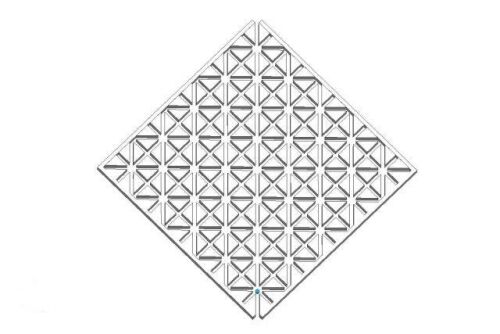
Fig. 22
In this two-dimensional space, the being can only see the closest path and. at the nearest junction (in this model, not in real life), only two or three possible directions, and the being may choose only one of them. Multi-dimensional beings, higher intelligences, or even people in an expanded state of consciousness are able to perceive the maze from a third (in the model, otherwise, fourth) spatial dimension and see what awaits us when choosing a given direction at the next junction, or junctions.
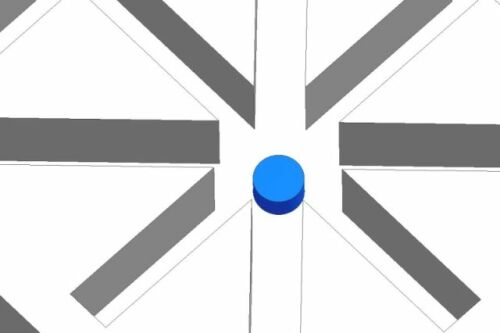
Fig. 23
These consciousnesses see our probabilistic future and are therefore able to predict, to a certain extent, what awaits us in the future. They also often have information about our past decisions, our choices at previous junctions, and can create an image about how we will probably react to a given situation. The decision on which direction we will take at the junction, which path we will choose, is entirely up to us. Only we decide which of the probabilistic futures that we have at hand we’ll choose. It is clear from this model that we have the most alternatives in the middle of our lives and the least at the beginning and the end. But if we already are in the middle of our lives, and therefore in a given point of our maze, due to our previous decisions, we don’t have the possibility of going through all the alternatives we had at birth.
We must not forget, however, the difficulty of predicting the future lies in the fact that our life’s journey is not only affected by our decisions and choices, but also by those of other beings.
Time does not move linearly, but has a cyclic character. A more accurate model of time would be a spiral made of spirals, made of spirals …
With this regard, it is necessary to point out that the model of existence in this chapter may be in apparent contradiction with those in previous chapters. This is because each model attempts to capture a different aspect of existence in a simplified way so it would be comprehensible for the average person.
Among others, this is a problem faced also by modern physics, and it’s no reason to judge one model as false or to conclude that the World is absurd.
The model of the world created from each entity of consciousness is analogous to the model of existence according to string theory.
Simply put, according to string theory, the basis of the entire Universe are one-dimensional strings, which, depending on how they vibrate, are this or that particle.
In our string model (the Beings are also the core of the existence of strings), the Beings are an homogeneous “substance”. and, according to how they vibrate, they manifest as individual beings in a given incarnation.
As mentioned in Chapter 5, the comprehensive model of existence illustrated herein, when properly used, can work like the Mendeleyev’s Periodic Table of the Elements. Seeing this model of existence as a coherent system, when you look for the answer to a given question, it is important to place that question correctly within the system—the model of existence—and the answer will emerge by itself from the relations with the neighbouring points of the system. I deliberately refrained from saying the “correct” answer because that would assume that this model of existence is accurate, which I dare not say so explicitly.
For clarity, here is an example.
Question: Is it possible to incarnate as animal after having incarnated as human? If we apply the model of existence herein, we see that everything happens simultaneously, including the past, present and future lives, and from this perspective, the question makes no sense.
From the model of Beings as one-dimensional strings, where the only dimension is time, on the time axis representing the development of the Being, a higher level of development cannot logically be followed by a lower one (assuming that we consider humans to be a higher level than animals, which unfortunately, with regards to our daily experience, does not always seem to be the case).
This shows that the question doesn’t have a simple answer.